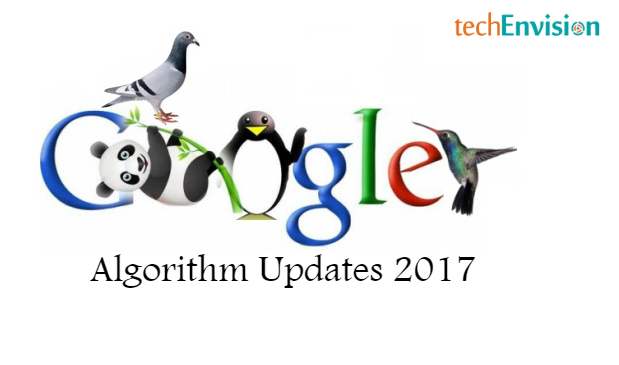
Google Algorithmic Changes 2017
Search engine optimization (SEO) is the process of affecting the visibility of a website or a web page in a web search engine’s unpaid results—often referred to as “natural”, “organic”, or “earned” results.
The SEO updates are directly proportional to the search algorithm updates that search engines receive. Since Google is the pioneer in the search Engine marketing, new changes in Google’s search algorithms are vital to enhance optimization of your website.
Largely, Google is centered on enhancing its web search administrations for online users, and by keeping a track of changes in the Google Search Algorithm updates, marketers can increase ranking of their sites. Google has a long history of famous search algorithm updates that channelize ranking mechanism of SERPs.
To find latest Google SEO updates, we need to check following updates
Google Hummingbird
Google started using Hummingbird about August 30, 2013 and announced the change on September 26 on the eve of the company’s 15th anniversary. It is made up of 200+ factors that can affect search results and website ranking. The biggest changes made in Hummingbird were capability to have a sharp eye on mobile marketing, which is not surprising at all given the explosion of the smart phones in recent years. Google said that Hummingbird is paying more attention to each word in a query, ensuring that the whole query—the whole sentence or conversation or meaning—is taken into account.
Recent Updates related to Hummingbird
Application of meaning technology to billions of pages from across the web
Use of Knowledge Graph facts to ensure better search results
Easy recognition of Keyword stuffing
Effectiveness of Long-tail keywords
Google Penguin
Google launched the Penguin Update in April 2012 to better catch sites deemed to be spamming its search results, in particular those doing so by buying links or obtaining them through link networks designed primarily to boost Google rankings.
SEO Updates related to Google Penguin
Penguin 1-on April 24, 2012 (impacting around 3.1% of queries)
Penguin 2-on May 26, 2012 (impacting less than 0.1%)
Penguin 3-on October 5, 2012 (impacting around 0.3% of queries)
Penguin 4(a.k.a. Penguin 2.0)- on May 22, 2013 (impacting 2.3% of queries)
Penguin 5(a.k.a. Penguin 2.1)- on October 4, 2013 (impacting around 1% of queries)
Penguin 6(a.k.a. Penguin 3.0) – on October 17, 2014 (impacting less than 1% English queries). On December 1, 2014, Google confirmed that the update was still rolling out with webmasters continuing to report significant fluctuations.
Penguin 7(a.k.a. Penguin 4.0)- on September 23, 2016
Google Pigeon
Google Pigeon is the code name given to one of Google’s local search algorithm updates. This update was released on 24 July 2014.The update is aimed to increase the ranking of local listing in a search. The changes will also affect the search results shown in Google Maps along with the regular Google search results. As of now, it has been released in US English and will shortly be released in other languages and locations. This update provides the results based on the user location and the listing available in the local directory.
Integrated deeper into its previous algorithm, the Pigeon ties into Google’s search capabilities to include hundreds of ranking signals the company use, including other features such as Knowledge Graph, spelling correction, synonyms and more.
Recent Updates Related to Google Pigeon
Location Matters More Than Ever
Don’t Over-Optimize Your Website
Strong Domains Matter more
Google Panda
Google Panda is a change to Google’s search results ranking algorithm that was first released in February 2011. The change aimed to lower the rank of “low-quality sites” or “thin sites” in particular “content farms” and return higher-quality sites near the top of the search results.
The name “Panda” comes from Google engineer Navneet Panda, who developed the technology that made it possible for Google to create and implement the algorithm.
SEO Updates Related to Google Panda Update
No Multiple Pages with the Same Keyword
Get Rid of Auto-generated Content and Roundup/Comparison Type of Pages
No Pages with 1-2 Paragraphs of Text Only
No Scraped Content
Panda Likes New Content
Be Careful with Affiliate Links and Ads
Too Many Outbound Links with Keywords are bad

Google Mobile-Friendly Update
Introduced On April 21, 2015, Google introduced its Mobile-Friendly search algorithm that is intended to give a lift to mobile friendly sites pages in Google’s mobile search results. The change is significant to the point that the date it happened is being alluded by a variety of names such as Mobilegeddon, Mobilepocalyse, Mopocalypse or Mobocalypse. One of the ideal approaches to get ready is to test that Google considers your site pages to be mobile friendly by utilizing its Mobile-Friendly Test tool
Recent Updates Related to Google Mobile-Friendly
Google may pick desktop over AMP page for the mobile-first index
Google mobile-friendly testing tool now has API access
Google begins mobile-first indexing, using mobile content for all search rankings
Google will show AMP URLs before App deep link URLs in mobile results
Google says page speed ranking factor to use mobile page speed for mobile sites
Google Payday Loan Algorithm
Introduced on June 11, 2013, Google Payday Update was a new Google search algorithm focused at cleaning up list items related to “spammy queries” such as payday loans or pornographic or some other kinds of heavily spammed queries. It can be understood as a set of algorithm updates for the Google search engine results initiated to identify and penalize websites that use different kinds of search engine spam techniques (also known as Black Hat SEO or spamdexing) for improving their rankings for particular search queries that are actually “spammy”.
Recent Updates
Google Payday Loan 1.0
Google Payday Loan 2.0
Google Payday Loan 3.0
Google’s Pirate
Introduced in August 2012, Google’s Pirate Update is a filter that prevents sites that have many copyright infringement reports, as documented through Google’s DMCA system. It is periodically updated and at the point when updates happen, websites beforehand affected may get away, if they have made the correct changes. It may likewise catch new websites that circumvented being caught recently; in addition, it may also release ‘false positives’ about those who were caught.
Some of the latest Google Pirate SEO updates
The Pirate Update Penalized Websites That Received A High Volume Of Copyright Violation Reports
The Pirate Update Is A Win For Media And Artists
Getting A Page Removed From The Index Requires Valid Documentation
Google’s EMD
The EMD Update for “Exact Match Domain” — is a filter Google launched in September 2012 to prevent poor quality sites from ranking well simply because they had words that match search terms in their domain names. … New sites with poor content — or those previously missed by EMD — may get caught.
According to Matt Cutts, “EMD is set to reduce low-quality ‘exact-match’ domains in search Results.”
Google’s Top Heavy Algorithm
Google Top Heavy update was launched in January 2012 as a way to avoid sites that were “top heavy” with advertisements from positioning well in Google search listings. Top Heavy is updated repeatedly, and at the point when a Top Heavy Update occurs, websites that have evacuated extreme advertisements may recapture their lost rankings. New sites considered as “top heavy” may get caught again with new Top-heavy update.
Recent Updates
Google Updates Its Page Layout Algorithm To Go After Sites “Top Heavy” With Ads
Have The Same Ad-To-Organic Ratio As Google Search? Then You Might Be Safe From The Top Heavy Penalty
The Top Heavy Update: Pages With Too Many Ads Above The Fold Now Penalized By Google’s “Page Layout” Algorithm
Google’s Pagerank Algo
PageRank is an algorithm used by Google Search to rank websites in their search engine results. PageRank was named after Larry Page, one of the founders of Google. PageRank is a way of measuring the importance of website pages. According to Google:
PageRank works by counting the number and quality of links to a page to determine a rough estimate of how important the website is. The underlying assumption is that more important websites are likely to receive more links from other websites.
It is not the only algorithm used by Google to order search engine results, but it is the first algorithm that was used by the company, and it is the best-known.
The original PageRank algorithm was described by Lawrence Page and Sergey Brin in several publications. It is given by
PR(A) = (1-d) + d (PR(T1)/C(T1) + … + PR(Tn)/C(Tn))
Where,
– PR(A) is the PageRank of page A,
– PR(Ti) is the PageRank of pages Ti which link to page A,
– C(Ti) is the number of outbound links on page Ti and
– d is a damping factor which can be set between 0 and 1.
Stay in touch with techEnvision for all Google SEO Updates & algorithmic changes.
Call on for any query – 91 9561770305, 9860995414
Reference – www.searchengineland.com, www.moz.com



